Dog Days, with no dogs invited
By John Gilbert
The dog days of late summer can wear you down with the last blast of heat and humidity, but there are some automotive remedies.
The worst dog days are not at all depressing if experienced from behind the wheel of a convertible. There are a growing list of drop-tops, and if you want to be sure no dogs are allowed, consider as an assortment that includes a BMW, such as the 650i; a Jaguar, particularly the XK-R; and a couple of Chevrolets, whether a Corvette or a Camaro.
With any of these, the evidence is convincing that there is no better way to dispose of a little disposable income to be able to take in the passing scenery than with the windblown rays of sunshine blowing through your hair.
Not too many years ago, convertibles seemed to be vanishing from showrooms and roadways, but they have resolutely moved back into the marketplace in a quite remarkable assortment that allows consumers to pick their price range and find an applicable model. The convertible mix we’re discussing starts with a couple of vehicles such as the 2012 BMW 650i, at $107,000, or a 2011 Jaguar XK-R roadster, at $104,000 — both exotic enough that you won’t see another one on your neighborhood streets every day.
There is a far greater chance of seeing other Corvette convertibles, from vintage models to 2011a, although it will take from $60,000 to $75,000 to
get into a new Grand Sport model. Chevrolet also offers more reasonably priced Camaro convertibles, in both mild (the RS with a V6) at close to $30,000, or wild (the SS with a huge V8), for $40,000-$43,000. Camaro was doing a good job of challenging Ford’s ubiquitous Mustang, and added the convertibles for 2011 to broaden its appeal.
Up North, we donate aout half our driving season to winter or the chill of fall and early spring, so when it’s adequately warm out, we put our tops down at every chance to soak up every available ray of sun. Recently, though, I proved you can overdo it. Driving that 2012 BMW 650i during some 100-degree days in Minneapolis and Saint Paul, I was determined to keep the top down on a short trip, and I paid for it with a little sunburn on my wrist and neck.
Some Northerners park their roadsters for the winter, which is understandable, although others drive them year-round, either out of necessity or simply wanting to continue enjoying the car’s unquestioned sporty flair and agility, even when traction liabilities threaten the predominately rear-wheel-drive layouts.
My own private rules for convertibles, by the way, are that when you put the top down, you must also put the side windows down. Nothing is wimpier than having the top down on a convertible with the side windows rolled up, and it eliminates much of the sportiness of the top-down shape as well. That doesn’t mean you have to suffer when a nice, warm day turns chilly. In my convertible world, you can wear a sweatshirt or jacket, on up to a down parka and gloves, and you can crank up the heater or the seat heater, if need be. But if you have to put up the side windows, then put the top up, too. Read more
SRT Creates Four Chrysler-Dodge-Jeep Hot Rods
By John Gilbert
A group of Dodge and Chrysler engineers who mostly loved high-performance cars worked behind the scenes to try to bolster some sporty vehicles with sizzling performance. In 2002, that group gained respectability with the title of SRT, standing for the models modified up to Street and Racing Technology standards — following up in various degrees from the 2003 Dodge Viper sports car.
With Fiat only a year into taking ownership of Chrysler Group, we shouldn’t be surprised that the Italian company is going to keep SRT alive, and is elevating it to a separate brand to develop a stable of high-performance vehicles. After all, Fiat also owns Ferrari and Alfa Romeo, a couple of nameplates that know their way around a race track.
Specific models for the 2012 model year SRT8 modifications are the Dodge Challenger and Charger, Chrysler 300, and Jeep Grand Cherokee. All share SRT’s five requirements: awe-inspiring powertrain; ride and handling capability; benchmark braking; aggressive but functional exterior design; and performance-inspired interiors.
A familiar form leads the pack. The Challenger SRT8 pony car became a star of last winter’s auto show circuit displaying new striping, and “392†designation for the cubic inch equivalent of 6.4 liters.
Joining it in the SRT stable is the redesigned Charger SRT8, while Chrysler gets into the act with the 300 SRT8. Rounding out the group is the return of the surprisingly refined Grand Cherokee SRT8, which was a show-stopper in its first version, and has evolved into the larger, new-for-2011 Grand Cherokee.
Accompanying Fiat’s well-executed redesign of the interiors of all Chrysler Group models, the exteriors were either slightly revised, as in the Challenger and Chrysler 300, or totally redone, as in the Charger. Key to all SRT models, and the basis for meeting the five-point corporate demands, is the newly enlarged 6.4-liter Hemi V8, the common SRT weapon of choice, with power numbers that are close to astronomical and an accompanying improvement in fuel-efficiency and refinement.
I had gotten to know some of the original SRT engineers when the 2.7 V6 was introduced in the then-new Dodge Intrepid. Months later, when the Dodge Stratus and Chrysler Sebring midsize sedans were introduced, one engineer summoned me away from the group for a brief, private test-drive up and down a Seattle freeway in a one-off Dodge Stratus. With a modified 2.7-liter V6, firmed-up suspension, special wheels, and a six-speed stick, it was a blast to drive. Sadly, the expense, to say nothing of the venture’s boldness, prevented it from becoming an anticipated Stratus R/T production project.
But those bold engineers had laid the groundwork for SRT. Almost a full decade, and a corporate bailout and ensuing takeover by Fiat later, I was invited to join the group of automotive journalists in Los Angeles to try out all four of the 2012 vehicles under the new SRT umbrella.
The heart of SRT is the modernized Hemi. I’m more of a fan of small, over-achieving high-tech — but expensive — engines than the concept of enlarging huge pushrod V8s, the way General Motors and Chrysler continue doing with their highest-performance engines. But the new Hemi, enlarged from 6.1 to 6.4 liters, is a stunning performer.
In the Charger, Challenger and 300, the SRT8 engine has 470 horsepower and 470 foot-pounds of torque, while the Grand Cherokee SRT8 has 470 horses and 465 foot-pounds of torque.
“We were getting 420 foot-pounds of torque out of the 6.1 Hemi, and with the 6.4, we’re up to 470, along with the 470 horsepower,†said chief engineer Gary Rogers. “We have completely redone the cylinder heads, with larger ports on both intake and exhaust. The valves are 1.5 millimeters larger, with hollow stems, and the exhaust valves are sodium-filled. The active intake manifold is made of composite to reduce weight, and it has both long runners for low-speed torque, and short runners for high-speed horsepower.
Also improved is the Hemi’s cylinder-deactivation system, which cuts out the operation of four of the eight cylinders whenever the full power of eight cylinders is not demanded. Chrysler used to call it a “multi-displacement†system, and now it has evolved to “fuel saver technology,†although all the aliases fail to convey what the technique does as well as the simple cylinder-deactivation tag. When cruising, the broadened range of the revised system never betrays the fact that only four cylinders are operating, except for a little “Eco†light that appears on the instrument panel. When you hit the gas to accelerate for a pass or merge, the full power comes on forcefully but seamlessly. It hits 0-60 mph in the high-4-second range, and yet should top the EPA estimated 22 miles per gallon in freeway cruising, if you can resist summoning that abundant power.
“We also have variable valve-timing, and oil squirters that shoot up to lubricate and cool the bottom of the pistons,†said Rogers. “With all the changes, we were able to raise the compression ratio from 10.3-1 to 10.9-1.â€
A five-speed automatic handles the power, awaiting expansion of Chrysler’s new eight-speed that will debut on the very strong V6 Dodge and Chrysler models.
Adaptive suspension, with switchable dampers to sport mode, complements the improved chassis and steering to fulfill the ride/handling point, without the anticipated, or previous, driving harshness. Braking is improved by larger Brembo brakes to put all SRT vehicles into the 115-120 foot range for 60-0 stops. The exterior designs are aimed at styling cues that all are functional to enhance aerodynamics as part of the aggressive styling rule. Finally, high-quality materials line the interiors, with everything from new steering wheels and rich wood and leather trim, to performance hardware and the surround-sound audio.
Ralph Gilles, a sharp executive who was the president and CEO of Dodge, has been shifted to the same titles with the new SRT brand, as well as SRT involvement in motorsports. “SRT has learned a lot — about cars, ourselves, and our customers,†said Gilles, recounting the evolution of SRT since 2002.
“This is the second turn for some of the SRT vehicles,†Gilles added. “We’ve made these cars more intelligent. Our active suspension was somewhat jittery, not we’ve found a way to smooth that out. Our Harmon-Kardon audio system is unlike anything we’ve ever put in a car. And each of the SRT cars has its own identity. Every line and scoop is functional, to control aerodynamic lift and airflow. On the Chrysler 300 SRT8, its less ostentatious, while the Charger is the opposite. And the Grand Cherokee SRT8 is a masterpiece; we’ve found a way to balance itself for performance.â€
We drove from our Hollywood hotel a couple hours to the rural California location of Willow Springs, a legendary facility that was the first road-racing circuit in the United States. It has a little bit of everything, with turns both tricky and fast, up and down some hills. It starts with an uphill left leading to a series of tight turns over varying elevation rises from the pit-lane exit at the far end of the main straightaway. A couple more tight turns peak with two right turns circling at the highest point, before plunging down some tight but fast backside turns to a decent straight leading to the final sweeping pair of right turns that return to the main straightaway, with its pit entrance and the start-finish line. We drove each car on a warm-up lap, then three laps as hot as we wanted to go, then a cool-down lap.
My partner and I drove a Chrysler 300SRT8 to the track, and a brief stop for driver changes provided the opportunity to appreciate the dashing good looks of the new Charger SRT8. The basic Charger looks leaner and meaner, with neatly sculpted contours carved into the sides and a more impressive grille and tail. The SRT8 version adds a blacked-out grille that is much more pronounced with its menacing opening, and other modifications, such as a rear spoiler wing, that separate the SRT8 from the herd.
A brief look at all four vehicles begs for more thorough test-driving.
Dodge Challenger SRT8:
Competing against the Mustang and Camaro, the Challenger recaptures the heyday of the 1970 Trans-Am racer in design, so the SRT8 application makes the least alterations to the already-sporty appearance of the Challenger. The increased power of the 6.4 Hemi, however, makes the Challenger SRT8 perform with a smoother and more refined feel. Improved suspension makes the still-heavy coupe feel more tossable in tight turns than its larger SRT8 cousins. A manual switch allows changing to firmer sport handling.
Dodge Charger SRT8:
The visual impact of the newly redesigned Charger is eye-catching wherever you drive. The previous Charger was impressive looking in a bold and overpowering way, while the new one is sleek and sporty in its styling, befitting the improved suspension compliance and the new engine’s power surge. Clicking the U-Connect switch on the media center provides the option of automatic or sport suspension, allowing for very good handling in normal driving, and firming up a notch for sports performance.
Chrysler 300SRT8:
This car was the biggest surprise to me, because the luxurious leather and wood interior convinces you it’s a luxury car, but the performance kick and excellent handling — even on the race track, with electronic sport setting — proves that it’s a high performer as well. Similar to Cadillac’s CTS-V, the 300SRT8 is worthy of
taking on such German performers as the BMW M5. In fact, comparing the very impressive interiors of the BMW M5, Mercedes AMG63, Audi A7 and the Chrysler 300SRT8, with the logos hidden, I think most would choose the 300SRT8.
Jeep Grand Cherokee SRT8:
Because the new Grand Cherokee is wider and heavier, the biggest challenge was to turn that off-road and country club hauler into a sporty vehicle. SRT did it, and what appears to be a top-heavy SUV ready for Moab is transformed into a great-handling road-racer in SRT8 form. A 5-mode switch allows for all different handling needs, and it’s hard to imagine someone speeding off for a weekend of rock-crawling in such a potent package. With 5,100-pound curb weight, 6-rotor calipers handle the braking, and the aero styling changes lift to downforce. A 5,000-pound tow rating means hauling boats, horses, ATVs, motorcycles or snowmobiles in swift style.
In all four SRT8 models, the five-speed automatic can be manually shifted, with steering wheel paddles. In normal driving, the transmission will force an upshift if the driver gets too close to redline, but in sport setting, it holds the gear until shift-or-else time.
The audio system, by Harmon Kardon and with electronics by Panasonic, is a 900-watt powerhouse with 18 speakers in the Challenger and 19 in the other three. It is 19 pounds lighter than the previous system, and it has full surround sound. It’s very good, especially for those who aren’t yet convinced that the sweet music of that big Hemi isn’t sufficient.


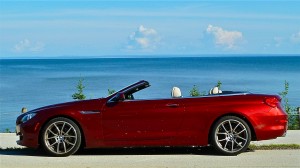
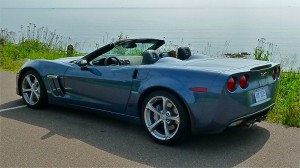
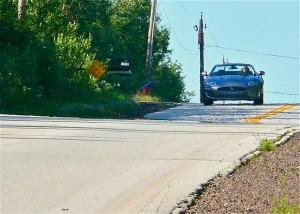
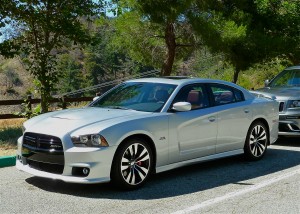
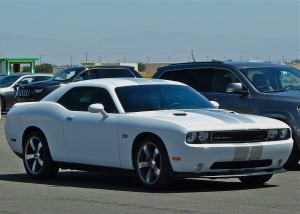
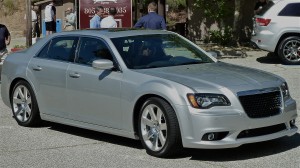
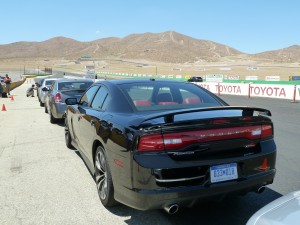
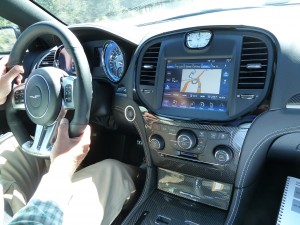
 John Gilbert is a lifetime Minnesotan and career journalist, specializing in cars and sports during and since spending 30 years at the Minneapolis Tribune, now the Star Tribune. More recently, he has continued translating the high-tech world of autos and sharing his passionate insights as a freelance writer/photographer/broadcaster. A member of the prestigious North American Car and Truck of the Year jury since 1993. John can be heard Monday-Friday from 9-11am on 610 KDAL(www.kdal610.com) on the "John Gilbert Show," and writes a column in the Duluth Reader.
John Gilbert is a lifetime Minnesotan and career journalist, specializing in cars and sports during and since spending 30 years at the Minneapolis Tribune, now the Star Tribune. More recently, he has continued translating the high-tech world of autos and sharing his passionate insights as a freelance writer/photographer/broadcaster. A member of the prestigious North American Car and Truck of the Year jury since 1993. John can be heard Monday-Friday from 9-11am on 610 KDAL(www.kdal610.com) on the "John Gilbert Show," and writes a column in the Duluth Reader.